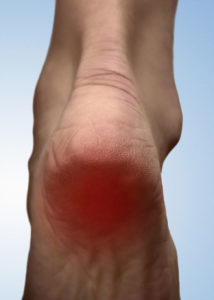Heel pain is one of the most common problems that brings people into our office. Oftentimes their pain is brought on by a fall or by stepping on a rock, but other times we find ourselves fielding questions from parents about their child’s heel pain. Heel pain in children is not all that uncommon; in fact, its medical term is called calcaneal apophysitis. Today, we explain why your child may be experiencing heel pain, and what you can do about it.
Heel Pain In Children
 The onset of heel pain in children is actually quite common, especially between the ages of 8 and 14. That’s because the heel bone is going through its final stages of development during this time. If you repeatedly stress the growth plate in your heel during this time, inflammation can set in. The onset of inflammation is known as calcaneal apophysitis. The condition is also known by a different name – Sever’s Disease.
The onset of heel pain in children is actually quite common, especially between the ages of 8 and 14. That’s because the heel bone is going through its final stages of development during this time. If you repeatedly stress the growth plate in your heel during this time, inflammation can set in. The onset of inflammation is known as calcaneal apophysitis. The condition is also known by a different name – Sever’s Disease.
Sever’s disease is a little bit of a misnomer because it’s a condition, not a disease. In fact, it’s the most common cause of heel pain in children, and it can occur in one or both feet. The most common cause of Sever’s disease in children is from overuse and stress, and oftentimes this occurs in physical activity or sports. Their feet are sensitive while growing, so a lot of running and jumping on hard surfaces can lead to inflammation in the heel. Children who play soccer, basketball and those who run track are at the greatest risk for heel pain during this stage of their life. Aside from overstress, other potential causes of calcaneal apophysitis include obesity, tightness in the Achilles tendon, and mechanical foot disorders like flat feet or a high arch.
Symptoms and Treatment Of Heel Pain
The most common symptoms of calcaneal apophysitis in children include:
- Heel pain
- Walking with a limp
- Toe walking
- Difficulty running, walking, jumping or participating in physical activity
- Pain on the side of the heel when the heel is compressed
Diagnosing the condition is pretty straightforward. The foot specialist begins by conducting a physical exam of the child’s foot and asking about medical and family history. An x-ray is usually ordered to confirm the diagnosis, and in rare cases other imaging techniques or tests may be ordered.
If it is determined that your child is dealing with Sever’s disease, you’ll be briefed on a couple of different treatment options. All of these options are non-surgical, and may be used in combination with one another. The child may be asked to reduce certain activities for a period of time, to try a heel support or custom orthotic device when walking or during physical activity, to participate in physical activity to promote healing of the inflamed tissue or to take NSAIDs to help combat the inflammation. In severe cases, the child may be asked to wear an immobilization cast or boot in order to keep the area immobile so that healing can occur.
Other ways to prevent the onset of calcaneal apophysitis include helping the child maintain a healthy weight, ensuring they have supportive shoes, and avoiding excessive physical activity or activity beyond their ability level.